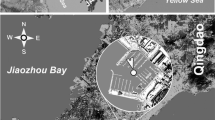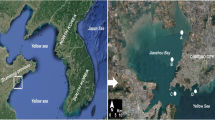Abstract
The colonization dynamics in trophic-functional patterns of periphytic protist communities was studied in coastal waters of the Yellow Sea, northern China, from May to June, 2010. The periphytic protists represented different trophic-functional structures during colonization process. Only certain trophic-functional groups (e.g., photoautotrophs, algivores and non-selectives) occurred within the protist communities with low species number and abundance at the initial stage (1–3 days), while more trophic-functional groups (e.g., photoautotrophs, algivores, non-selectives and raptors) contributed to the communities with increased and peaked species number and abundance at the transitional (7–10 days) and equilibrium (14–28 days) stages, respectively. All heterotrophic groups were significantly fitted the MacArthur–Wilson model in colonization curves and represented higher species number and colonization rates at a depth of 1 m than at 3 m. These results may provide necessary understandings for ecological researches and monitoring programs using periphytic protists with different colonization ages in marine ecosystems.






Similar content being viewed by others
References
Anderson MJ, Gorley RN, Clarke KR (2008) PERMANOVA+ for PRIMER guide to software and statistical methods. PRIMER-E Ltd, Plymouth
Azovsky AI (1988) Colonization of sand “islands” by psammophilous ciliates: the effect of microhabitat size and stage of succession. Oikos 51:48–56
Beech CD, Landers SC (2002) Ciliated protozoan colonization of substrates from Dauphin Island, Alabama. Europ J Protistol 38:83–89
Burkovskii IV, Mazei YA (2001) A study of ciliate colonization of unpopulated substrates of an estuary in the White Sea. Oceanology 41:845–852
Burkvskii IV, Mazei YA, Esaulov AS (2011) Influence of the period of existence of a biotope on the formation of the species structure of a marine psammophilous ciliate community. Russ J Mar Biol 37:177–184
Cairns J Jr, Henebry MS (1982) Interactive and noninteractive protozoa colonization process. In: Cairns J Jr (ed) Artificial substrates. Ann Arbor Science Publishers, Ann Arbor, pp 23–70
Clarke KR, Gorley RN (2006) User manual/tutorial. PRIMER-E Ltd, Plymouth
Debenest T, Pinelli E, Coste M, Silvestre J, Mazzella N, Madigou C, Delmas F (2009) Sensitivity of freshwater periphytic diatoms to agricultural herbicides. Aquat Toxicol 93:11–17
Duong TT, Feurtet-Mazel A, Coste M, Dang DK, Boudou A (2007) Dynamics of diatom colonization process in some rivers influenced by urban pollution (Hanoi, Vietnam). Ecol Indic 7:839–851
Duong TT, Morin S, Coste M, Herlory O, Feurtet-Mazel A, Boudou A (2010) Experimental toxicity and bioaccumulation of cadmium in freshwater periphytic diatoms in relation with biofilm maturity. Sci Total Environ 408:552–562
Fan X, Chen X, Song W, AL-Rasheid KAS, Warren A (2010) Two new marine scuticociliates, Sathrophilus planus n. sp. and Pseudoplatynematum dengi n. sp., with improved definition of Pseudoplatynematum (Ciliophora, Oligohymenophora). Eur J Protistol 46:212–220
Fenchel T (1969) The ecology of marine microbenthos. IV. Structure and function of the benthic ecosystem, its chemical and physical factors and the microfauna communities with special reference to the ciliated protozoa. Ophelia 6:1–182
Fernandez-Leborans G (2001) Relative importance of protozoan functional groups in three marine sublittoral areas. J Mar Biol Ass UK 81:735–750
Fernandez-Leborans G, Fernandez-Fernandez D (2002) Protist functional groups in a sublittoral estuarine epibenthic area. Estuaries 25:382–392
Fischer H, Sachse A, Steinberg CEW, Pusch M (2002) Differential retention and utilization of dissolved organic carbon by bacteria in river sediments. Limnol Oceanogr 47:1702–1711
Franco C, Esteban G, Téllez C (1998) Colonization and succession of ciliated protozoa associated with submerged leaves in a river. Limnologica 28:275–283
Früh D, Norf H, Weitere M (2011) Response of biofilm-dwelling ciliate communities to enrichment with algae. Aquat Microb Ecol 63:299–309
Geesey GG, Mutch R, Costerton JW, Green RB (1978) Sessile bacteria—important component of microbial-population in small mountain streams. Limonol Oceanogr 23:1214–1223
Gong J, Song W, Warren A (2005) Periphytic ciliate colonization: annual cycle and responses to environmental conditions. Aquat Microb Ecol 39:159–170
Gold C, Reurtet-Mazel A, Coste M, Boudou A (2002) Field transfer of periphytic diatom communities to assess short-term structural effects of metals (Cd, Zn). Water Res 36:3654–3664
Hausmann K (2002) Food acquisition, food ingestion and food digestion by protests. Jpn J Protozool 35:85–95
Have A (1993) Effects of area and patchiness on species richness: an experimental archipelago of ciliate microcosms. Oikos 66:493–500
Jiang J, Zhang Q, Warren A, Al-Rasheid KAS, Song W (2010) Morphology and SSU rRNA gene-based phylogeny of two marine Euplotes species, E. orientalis spec. nov. and E. raikovi Agamaliev, 1966 (Ciliophora, Euplotida). Eur J Protistol 46:121–132
Kathol M, Norf H, Arndt H, Weitere M (2009) Effects of temperature increase on the grazing of planktonic bacteria by biofilm-dwelling consumers. Aquat Microb Ecol 55:65–79
Kathol M, Fischer H, Weitere M (2011) Contribution of biofilm-dwelling consumers to pelagic-benthic coupling in a large river. Freshw Biol 56:1017–1230
Khatoon H, Yusoff FM, Banerjee S, Shariff M, Mohamed S (2007) Use of periphytic cyanobacterium and mixed diatoms coated substrate for improving water qualily, survival and growth of Penaeus monodon Fabricius postlarvae. Aquaculture 27:196–205
Kiørboe T, Grossart H-P, Ploug H, Tang K, Auer B (2004) Particle-associated flagellates: swimming patterns, colonization rates, and grazing on attached bacteria. Aquat Microb Ecol 35:141–152
MacArthur R, Wilson EO (1967) The theory of island biogeography. Princeton University Press, Princeton, pp 1–203
Morin S, Pesce S, Tlili A, Coste M, Montuelle B (2010) Recovery potential of periphytic communities in a river impacted by a vineyard watershed. Ecol Indic 10:419–426
Norf H, Weitere M (2010) Resource quality and seasonal background alter warming effects on communities of biofilm ciliates. FEMS Microbiol Ecol 74:361–370
Norf H, Arndt H, Weitere M (2007) Impact of local temperature increase on the early development of biofilm-associated ciliate communities. Oecologia 151:341–350
Norf H, Arndt H, Weitere M (2009a) Responses of biofilm-dwelling ciliate communities to planktonic and benthic resource enrichment. Microb Ecol 57:687–700
Norf H, Arndt H, Weitere M (2009b) Effects of resource supplements on mature ciliate biofilms: an empirical test using a new type of flow cell. Biofouling 25:769–778
Pan H, Huang J, Hu X, Fan X, Al-Rasheid KAS, Song W (2010) Morphology and SSU rRNA gene sequences of three marine ciliates from Yellow Sea, China, including one new species, Uronema heteromarinum nov. spec. (Ciliophora, Scuticociliatida). Acta Protozool 49:45–59
Parry JD (2004) Protozoan grazing of freshwater biofilms. Adv Appl Microbiol 54:167–196
Patterson DJ, Larsen J, Corliss JO (1989) The ecology of heterotrophic flagellates and ciliate living in marine sediments. Prog Protistol 3:185–277
Pratt J, Cairns J Jr (1985) Functional groups in the Protozoa: roles in differing ecosystems. J Protozool 32:415–423
Railkin AI (1995) Heterotrophic flagellates on artificial substrates in the White Sea. Cytology 37:951–957
Risse-Buhl U, Küsel K (2009) Colonization dynamics of biofilm-associated ciliate morphotypes at different flow velocities. Eur J Protistol 45:64–76
Scherwass A, Fischer Y, Arndt H (2005) Detritus as a potential food source for protozoans: utilization of fine particulate plant detritus by a heterotrophic flagellate, Chilomonas paramecium, and a ciliate, Tetrahymena pyriformis. Aquat Ecol 39:439–455
Song W, Warren A, Hu X (2009) Free-living ciliates in the Bohai and Yellow Seas, China. Science Press (in both Chinese and English), Beijing, pp 1–518
Steidinger K, Tangen K (1997) Identifying marine phytoplankton. Academic Press, San Diego
Strüder-Kypke MC (1999) Periphyton and sphagnicolous protists of dystrophic bog lakes (Brandenburg, Germany). I. Annual cycles, distribution and comparison to other lakes. Limnologica 29:393–406
Wang J, Yuan Y, Shen Y (1985) Data handling in studying the process of protozoan colonization by means of PFU method. Acta Hydrobiol Sin 9:344–350
Wey JK, Norf H, Arndt H, Weitere M (2009) Role of dispersal in shaping communities of ciliates and heterotrophic flagellates within riverine biofilms. Limnol Oceanogr 54:1615–1626
Xu M, Cao H, Xie P, Deng D, Feng W, Xu J (2005) Use of PFU protozoan community structural and functional characteristics in assessment of water quality in a large, highly polluted freshwater lake in China. J Environ Monit 7:670–674 (In Chinese, with English summary)
Xu H, Min GS, Choi JK, Kim SJ, Jung JH, Lim BJ (2009a) An approach to analyses of periphytic ciliate communities for monitoring water quality using a modified artificial substrate in Korean coastal waters. J Mar Biol Assoc UK 89:669–679
Xu H, Min GS, Choi JK, Jung JH, Park MH (2009b) An approach to analyses of periphytic ciliate colonization for monitoring water quality using a modified artificial substrate in Korean coastal waters. Mar Pollut Bull 58:1278–1285
Xu H, Warren A, AL-Rasheid KAS, Zhu M, Song W (2010) Planktonic protist communities in semi-enclosed mariculture waters: temporal dynamics of functional groups and their responses to environmental conditions. Acta Oceanol Sin 29:106–115
Xu H, Zhang W, Jiang Y, Zhu M, Al-Rasheid KAS, Warren A, Song W (2011a) An approach to determining the sampling effort for analyzing biofilm-dwelling ciliate colonization using an artificial substratum in coastal waters. Biofouling 27:357–366
Xu H, Zhang W, Jiang Y, Min GS, Choi JK (2011b) An approach to identifying potential surrogates of periphytic ciliate communities for monitoring water quality of coastal waters. Ecol Indic 11:1228–1234
Acknowledgments
This work was supported by “The Natural Science Foundation of China” (project number: 41076089). Our special thanks are due to Prof. Weibo Song, Laboratory of Protozoology, Institute of Evolution and Marine Biodiversity, Ocean University of China, for his helpful discussions during the preparation of the manuscript.
Author information
Authors and Affiliations
Corresponding author
Additional information
Communicated by M. Kühl.
Appendix
Appendix
Txonomic and trophic-functional data (Table 4).
Rights and permissions
About this article
Cite this article
Zhang, W., Xu, H., Jiang, Y. et al. Colonization dynamics in trophic-functional structure of periphytic protist communities in coastal waters. Mar Biol 159, 735–748 (2012). https://doi.org/10.1007/s00227-011-1850-0
Received:
Accepted:
Published:
Issue Date:
DOI: https://doi.org/10.1007/s00227-011-1850-0




